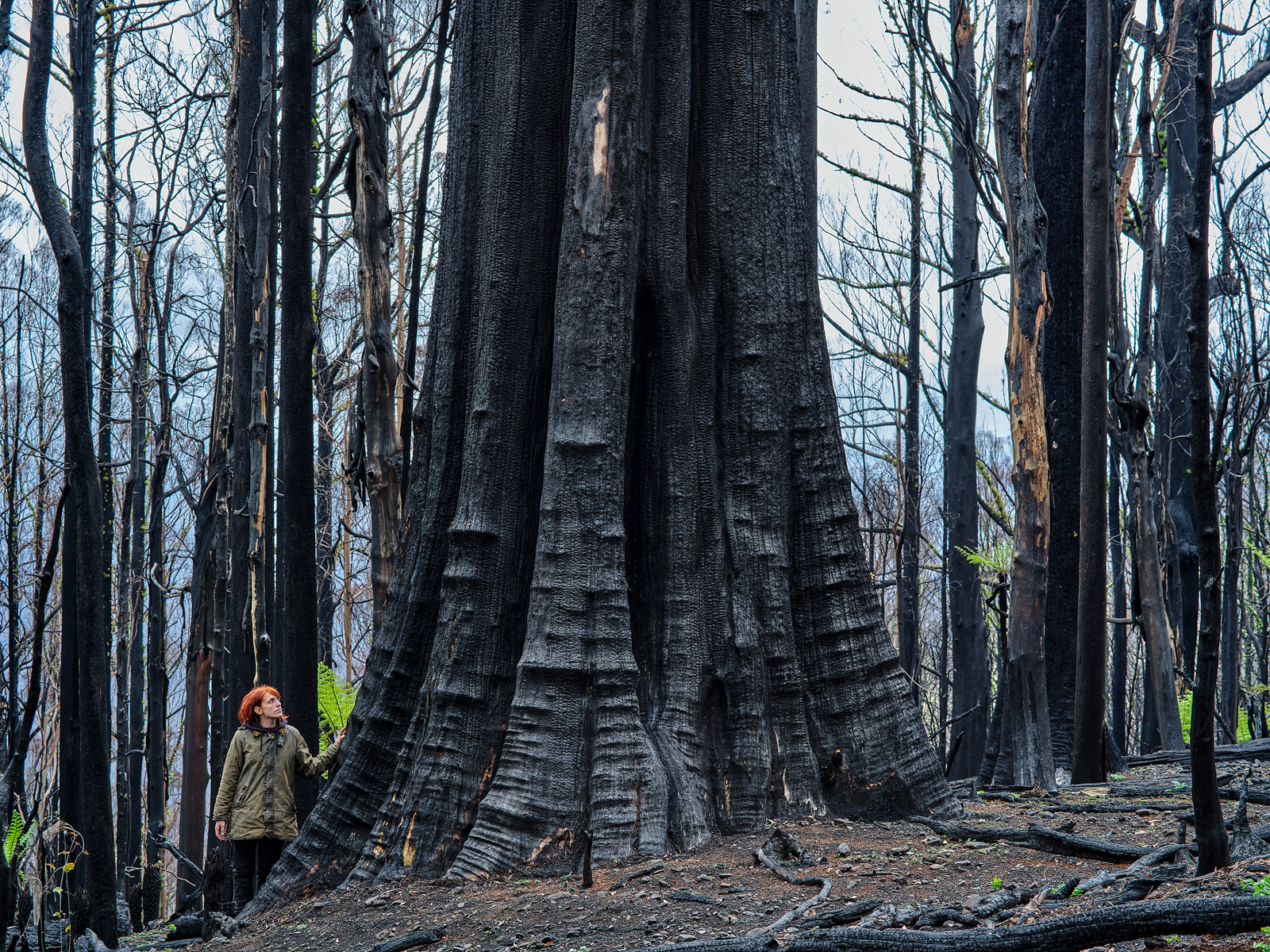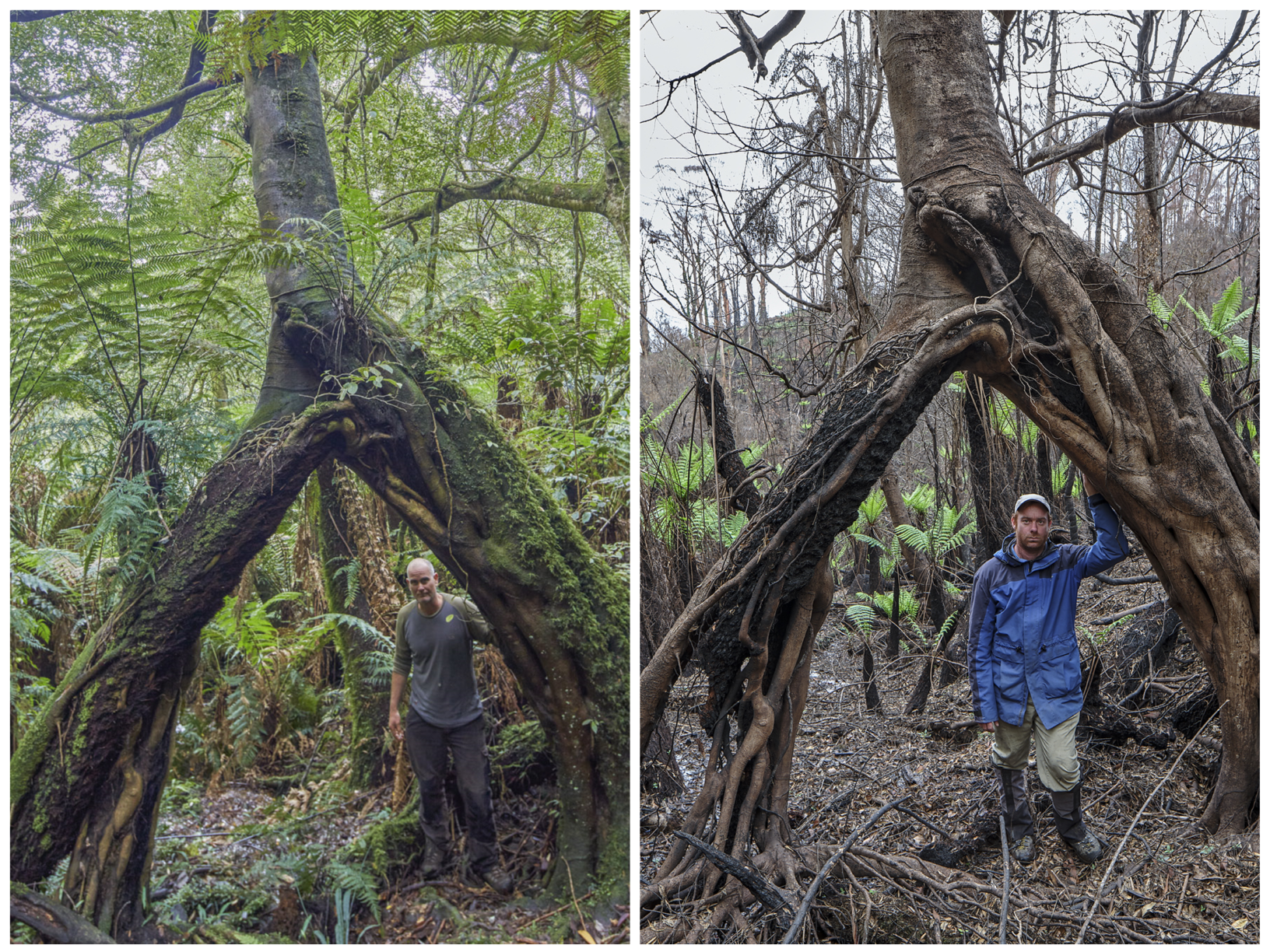After a five year long community campaign, the iconic Kuark forest in East Gippsland was finally protected by the Victorian government. Tragically, Kuark was severely impacted by the devastating fires of 2019/2020. Kuark forest was one of the most bio-diverse forests in Victoria, rich in wildlife, rare rainforest and old growth forests.
After months of wondering with hope and fear of how Kuark had been impacted by the fires, Tasmanian nature photographer Rob Blakers and GECO campaigners returned to the area to document the devastation. Sadly the scale and intensity of the destruction wrought by the fires is profoundly devastating. Read a report from The Guardian Australia here.

Mount Kuark old growth forest
All of Mt. Kuark has been severely burnt, with extensive stands of fire sensitive warm and cool temperate rainforest completely destroyed. The old growth rainforest areas will take centuries to recover and with climate change fuelled fires more fire likely to occur in the coming decades, it's unlikely these rainforests will ever recover.

Burnt cool temperate rainforest on Mt Kuark
Kuark was identified by the Victorian government as making one of the highest contributions to biodiversity values in the state, according to the environment department’s ‘nature print’ data set maps strategic biodiversity values. Kuark forest was a flagship area for biodiversity conservation. It's rainforests provided a rare window of insight into what Australia's forests looked like millions of years ago.

Ancient rainforest gullies incinerated, Larissa Lane
The forests of Kuark were once filled with birdsong. Now the silence is deafening, and the grief overwhelming.
It's hard to imagine that the forests of Kuark will ever be the same. But there are still very important forests in East Gippsland that did not burn that are threatened by logging. These forest need urgent protection.
While the logging industry in East Gippsland remains temporarily suspended, the Victorian government must bring forward their transition plan for workers and protect precious unburnt areas so wildlife and ecosystems have a chance to recover.
We won't see the recovery of some forests in our lifetime.
But the government can take action to protect unburnt forests and wildlife. They protected Kuark after years of dedicated community campaigning.
Now they must move to protect what remains.
 Burnt old growth wet forest on Mt Kuark
Burnt old growth wet forest on Mt Kuark
The community campaign to protect the Kuark forest led to several legal cases that challenged logging of precious wildlife habitat and old growth forest.
The campaign saw countless hours of citizen science surveys that collected evidence for court cases. Citizen science surveys led by GECO discovered the only known record of a rare fern deep in a gully within an area earmarked for logging.

Greens Road with the slopes of Mt. Kuark in the right of frame
In 2015 Environment East Gippsland sued the state government in the Supreme Court for failing to meet legal obligations to set aside legally required areas of habitat for Masked, Powerful and Sooty Owls. The case settled out of court and resulted in 2000 hectares of habitat, including important nesting habitat in old growth forests in Kuark.
Another Supreme Court case was lodged in 2016 by Environment East Gippsland that stopped logging in the Kuark forest with a legal injunction. The case argued that state owned logging agency VicForests had failed to detect and protect threatened flora and fauna. The case settled out of court and resulted in the government and VicForests agreeing not to log in several areas of the Kuark forest.

Burnt Sassafras in what was cool temperate rainforest, Kuark
A third case run by the Flora and Fauna Research Collective Inc (FFRC) commenced in 2017 after lawyers acting for the research collective argued that logging old growth forest in Kuark would be in breach of obligations to set aside minimum required areas of old growth wet and damp forest. Goongerah Environment Centre started a blockade which ran for 10 days whilst lawyers sought and won an interlocutory injunction that prevent logging in the forest.
 Logging was halted here by a legal injunction and the forest later protected
Logging was halted here by a legal injunction and the forest later protected
The FFRC Inc case was expanded to include 32 other areas of forest that the FFRC argued could not be logged as protection obligations were not being met. Several of these areas were in the Kuark forest and were protected by the Victorian government before the case reached judgement. Many are now burnt and some remain threatened by logging pending the outcome of the court case.

Mount Kuark
It's hard to reconcile with the scale and extent of impacts from the bushfires. Initial assessments of bushfire impacts have been detailed in a Victorian government report. According to the report:
● Over 40% of Victoria’s Sooty Owl habitat in within the burnt zone
● Over 25% of Victoria’s Greater Glider habitat is within the burnt zone
● 70% of Victoria’s Warm temperate rainforest is within the burnt zone
● 30% Victoria’s cool temperate rainforests are within the burnt zone
● 100% of the habitat for the East Gippsland Galaxias is within the burnt zone, this critically endangered species of fish is found nowhere else on earth other than the Kuark forest.

Mount Kuark
In November 2019, the Victorian Labor government announced protection for 96,000 hectares of forest across Victoria, with 48,500 in East Gippsland. These forests were designated as ‘Immediate Protection Areas (IPAs) and were part of a forestry package that attempted to address Victoria’s dwindling timber resources supply crisis with a $120 million dollar industry assistance package, a stepping down of native timber volumes from 2024 and a complete end of native forest logging by 2030.

Mt Kuark
The Immediate Protection Areas were a key component of the Greater Glider Action Statement that was released as part of the government forests package. The IPA's are supposed to provide habitat for the Glider while logging in unprotected areas occurs. But the Action Statement actually weakened existing older protections for the Greater Glider in East Gippsland and now according to analysis of government data of the fire extent, over 90% of the forests in the IPA's in East Gippsland have burnt.
The government's action plan for the Greater Glider is meaningless in light of the impacts of these fires, forests set aside for the species have been decimated so logging in high quality unburnt habitat now and in the near future will push this vulnerable animal closer to extinction.

Ancient Mountain Grey Gum burnt at Larissa Lane
We're heartbroken by the impacts to Kuark. But we'll be campaigning harder than ever for what remains.
Your donation can help us to keep up this important work, you can donate here.
We live and work on the land of the Gunaikurnai and Bidewell and Ngarigo and Yuin people. We pay respect to the thousands of years of their ongoing custodianship of the land. Sovereignty was never ceded. Always was always will be Aboriginal land. We pay our respects to Elders past, present, and emerging.
